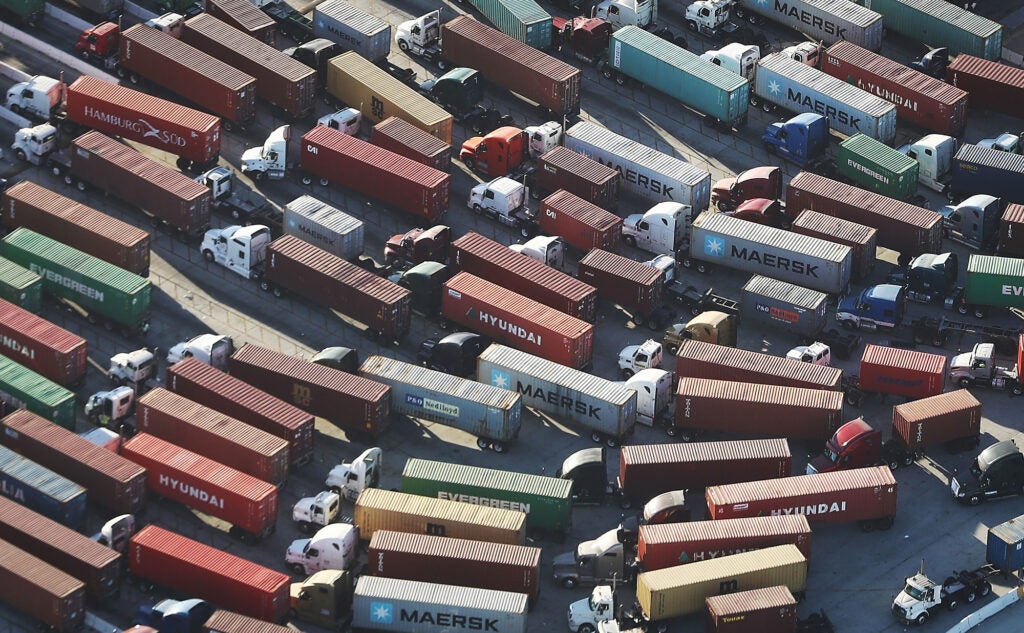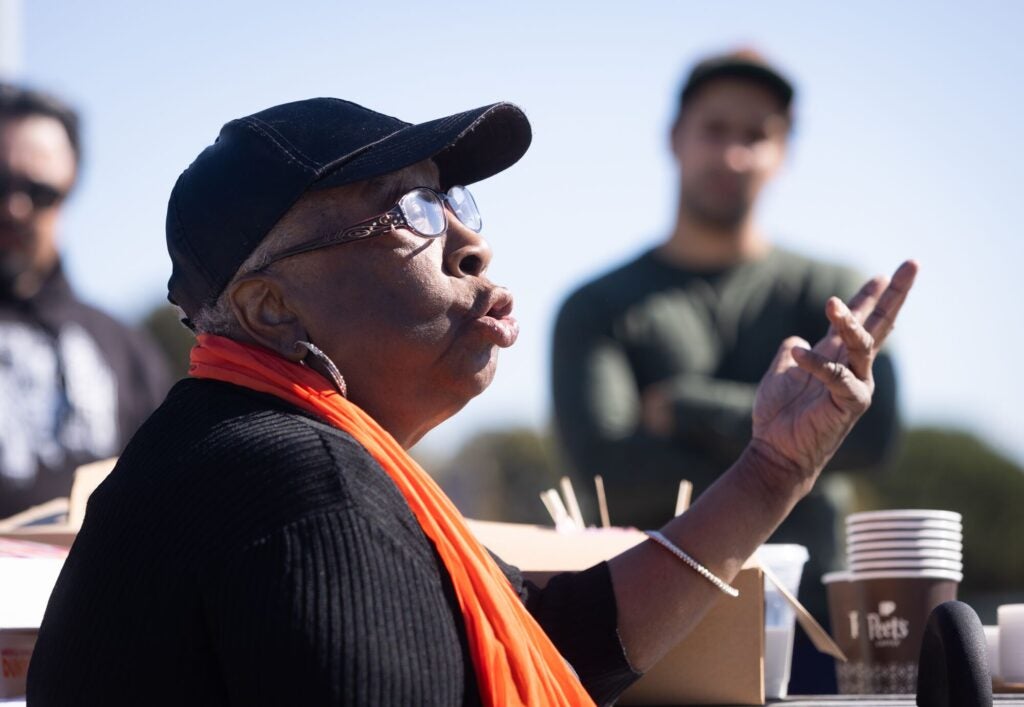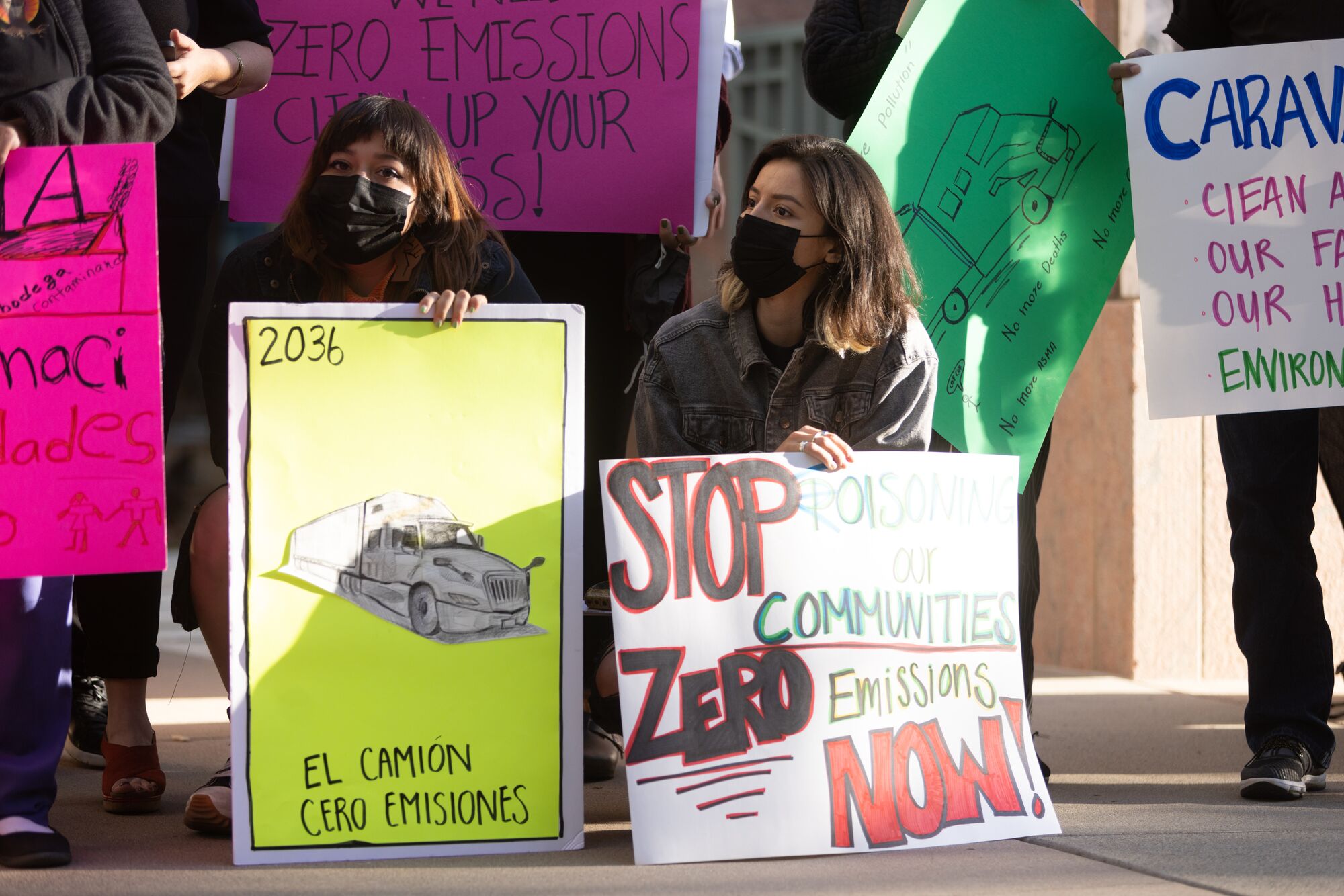In The Race to End Diesel Truck Pollution, California Widens Its Stride
California is not just staying in the running, but picking up the pace for zero emissions.

(Hannah Rothstein for Earthjustice)
Despite a decades-long battle against air pollution, Californians continue to breathe the dirtiest air in the country. Speeding the shift from diesel trucks — the largest source of lung-searing NOx pollution — to zero emissions is our greatest lever for progress. And the California Air Resources Board (CARB) is poised to push the shift into high gear. At its April board meeting, CARB will consider adopting its latest and most significant move to date to curb deadly truck pollution with the Advanced Clean Fleets (ACF) rule.
A Two-Pronged Approach to Accelerate the Shift
Part of what makes the ACF so effective at speeding the transition to zero emissions is that it tackles both the demand and the supply of zero emission (ZE) trucks.
First, the rule drives demand for zero-emission trucks by requiring the largest “high priority” fleets in California to turnover their fleets to zero emissions over the next two decades. CARB strategically varies the pace of transition based on trucks’ suitability for electrification. For example, public fleets in rural counties and long haul trucks get more time, while delivery and drayage trucks will shift faster. Drayage trucks are especially important: these heavy-duty tractors operate on mostly regional routes between ports and warehouses, imposing a severe pollution burden on nearby low-income communities. Recognizing the outsize benefit of electrifying drayage, CARB’s ACF rule will require any new sales of drayage trucks to be zero emission starting in 2024 — a timeline needed to meet Governor Newsom’s goal of 100% zero emission drayage by 2035.

Trucks haul shipping containers at the Port of Los Angeles, the nation’s busiest port. Trucks produce the pollution for 40% of California’s unhealthy smog problem. (Getty Images)
Just as important as fleet demand is zero-emission truck supply. CARB therefore also included a 100% sales requirement — a date by which all of a truckmakers’ sales must be zero emissions. The 100% sales requirement is crucial as it sends an unambiguous signal not only to manufacturers, but to their suppliers, fleets, utilities, and public agencies, to plan for a full transition. In the initial proposal, CARB staff suggested requiring 100% zero emission truck sales by 2040 — too late to achieve the Governor’s goal of all trucks on the road being zero emission by 2045 (as new trucks will stay on the road for over a decade). But the latest version of the rule accelerates the 100% sales target to 2036, just one year after the date required for cars. That would make California the undisputed global leader in zero emissions. Here’s the story of how it could happen.
From the Frontlines to the Halls of Power
For California’s low-income communities of color on the frontlines of freight pollution, this issue is life or death. When the initial ACF proposal was being considered in Sacramento, disparate freight communities across the state linked their local fights by launching a caravan up to the board meeting. Dubbed the “Route to Clean Air,” residents starting from the warehouse-sieged Inland Empire, and communities living in the shadow of the Nation’s largest port-complex in Long Beach, departed to meet with youth activists fighting against Port expansion in Oxnard, a heavily-industrialized city on the Central Coast. From there, they joined residents in the Central Valley battling freeway widening projects in the most polluted air basin in the nation. Traveling north, the groups weaved through mile-long lines of trucks at the Port of Oakland, to learn about one woman’s decades-long battle against the diesel-fueled asthma rates plaguing school children in West Oakland. The caravan carried their stories all the way to Sacramento, where dozens of communities urged CARB to deliver the state-wide support they needed to bring clean air to their communities. And they weren’t alone.

Ms. Margaret Gordon of the West Oakland Environmental Indicators Project speaks during an environmental justice caravan that visited polluted communities on the way to Sacramento to advocate for cleaner freight vehicles. (Chris Jordan-Bloch / Earthjustice)
An Unprecedented Coalition of Support
Communities fighting for their families and neighbors led the charge for an ambitious ACF rule, but the benefits of their actions will ripple far beyond the ports, railyards, and warehouses where truck trips cluster. This fact is reflected by the unprecedented coalition of support calling for California to strengthen the proposal. Over 50 organizations, spanning a wide range of public interests, wrote in support of the communities’ position.
Public health organizations highlighted how a strengthened ACF rule could save over 2,500 lives. In addition to the avoided emergency room visits and hospitalizations for heart and lung illness, these health benefits are valued at an estimated $26.5 billion.
Climate and environmental groups underscored that at a time when greenhouse gas emissions need to be in an unprecedented decline, freight emissions are actually rising. By strengthening the rule, CARB can respond to the clarion call of the International Panel on Climate Change (IPCC) to immediately accelerate action. The strengthened ACF rule nets nearly 25 million metric tons of annual, direct greenhouse gas reductions.
Business groups and fleets highlighted that strengthening the rule is an unquestionable boost for California’s economy. Even assuming all costs are borne by fleets, the operational advantages of zero trucks lead to $48 billion in net savings not including health or environmental benefits. In other words, the rule could be justified purely on economic grounds, because it results in savings that can be passed on from fleets to businesses and consumers.
Truck driver unions pointed to the ACF’s strategic definition of “controlling companies” to ensure that firms, and not drivers, would be accountable for the financial responsibility of transitioning. By strengthening the rule, CARB protects truck drivers from the notorious industry practice of “misclassification” which improperly treats employees as independent contractors.
Electrical workers unions also emphasized how a stronger rule would accelerate high-road job creation opportunities manufacturing zero emission trucks, and local jobs building and maintaining electrical charging infrastructure that can’t be offshored. Already, there are approximately 3,000 certified electricians in California with hundreds more to be certified annually.
And in an extraordinary show of support for their communities, 32 California legislators penned a letter to the Board, echoing the calls for the ACF rule to be further strengthened.
CARB Looks to Put the Public Interest First
It is not often the case that regulations grow stronger over the course of a rulemaking, where there is significant pressure from industry lobbying and political arm-twisting to water down health and environmental protection. But in this rulemaking, the opposite is happening. CARB appears to be prioritizing the voices of communities fighting for clean air over their naysayers. And with urgent Clean Air Act and climate action deadlines looming at the end of the decade, California is not just staying in the race, but picking up the pace.
This is not just empty ambition. Thanks to dramatic progress in electric truck technology, and the significant policy tailwinds from the federal government, CARB is seizing an opportunity for success that has never been greater.
Rapid Truck Electrification is Imminently Feasible
First, electric trucks save owners money (even faster than electric cars). CARB’s own total cost of ownership analysis finds that even without subsidies, zero emission vehicles are cheaper to own in every category by 2035. By 2030, they find electric trucks can pay themselves off in as little as two years. Thanks to the Inflation Reduction Act (IRA), those savings are even greater and more immediate. Analysts show that with the IRA’s commercial electric vehicle tax credit, zero emission trucks can be cheaper upfront as early as this year, and in every truck category by 2031.
Second, a widening share of trucks on the road are ready to go electric today. Just a few years ago, electric trucks were viewed as a niche solution for buses or vans that return to base. That view has quickly become outdated thanks to improving ranges and advancing charging options. By 2022, electric trucks were put to the test in on-road demonstrations, and led industry experts to determine that two-thirds of all medium-duty and half of all heavy-duty trucks are electrifiable today.
Third, charging infrastructure is rapidly ramping up. California is unleashing a torrent of funding and programs squarely focused on medium- and heavy-duty charging. In December, the CEC approved a record $2.9 billion investment in ZE infrastructure, $1.7 billion of which is specifically for truck and bus charging. The California Public Utilities Commission (CPUC) has directed utilities to deploy $1.44 billion through 2030 on truck charging, some of which is already operating. A big chunk of these chargers will also comply with new rules that will ensure speedy deployment, by requiring stations to be energized within an average of 125 days. Private investment is also crowding in from manufacturers, utilities, and truck stop operators.
Finally, momentum in the transition is snowballing. The pace of advancement in the past five years alone has been breathtaking, but it’s nothing compared to what we will see in the next five years. Bloomberg New Energy Finance found investment in electrified transport is “rocketing skywards” — up 54% just compared to 2021. There is enormous innovation in new battery chemistries, advances in fast charging management and circuit hardware, and new synergies that pair distributed solar and battery solutions to defray the need for costly grid upgrades. Massive federal investments are unleashing enormous tailwinds. We are just on the cusp of a revolution in transportation electrification, and CARB’s ACF is a crucial signal directing us closer to the breakthroughs and tipping points we need to hit to meet health and climate goals.
The ACF Needs to Be the Start of the New Era of Acceleration
Adopting the latest ACF rule could be the start of a refreshing era, where CARB strengthens and fast tracks life-saving and climate-protecting policies. And it must be. Because even with this rule in hand, significant additional action is needed to meet crucial air and climate goals. While it was strengthened, the ACF still leaves a lot of work for regulators to do in California.
The final proposal will still leave tens of thousands of highly polluting heavy duty tractors out of the regulation. The rule also includes numerous exemptions and extensions that, while important for offering flexibility to industry, could undermine the rule’s gains if not strictly enforced. To hedge against these limitations, CARB will need to quickly bring forward additional actions, like updating sales requirements to ramp up to the 100% sales requirement in 2036, and accelerating near-term action on highly-polluting tractors.
Nevertheless, the immediate passage of the current proposal is the surest way to catalyze the transition and build momentum. No other jurisdiction in the world has committed to 100% zero-emission truck sales by 2036. California, as the fourth largest global economy, is proving that it is prepared to take bold action to rein in one of its most polluting sectors, erode one of the largest sources of fossil fuel demand, and transition to an economy that delivers good jobs, clean air, and climate action. As the Environmental Protection Agency and the EU both consider setting their own truck standards, California’s standard sets a new stake in the ground: action cannot wait until the middle of this century. By listening to the communities on the frontlines of the crisis, California will pioneer the caliber of action that makes it a model for climate action across the globe.
The California Regional Office fights for the rights of all to a healthy environment regardless of where in the state they live; we fight to protect the magnificent natural spaces and wildlife found in California; and we fight to transition California to a zero-emissions future where cars, trucks, buildings, and power plants run on clean energy, not fossil fuels.
